Attività di sistema
Introduzione
Attività di sistema (System Activity) è simile al Task Manager di Microsoft Windows, all' Activity Monitor di Apple Mac OS X e al System Monitor di Gnome. Si apre quando premi la combinazione da tastiera Ctrl + Esc o tramite l'icona Attività di sistema ![]() in una finestra di KRunner (Alt + F2).
in una finestra di KRunner (Alt + F2).
Mostra un elenco dei processi attualmente in esecuzione insieme con il loro utilizzo CPU, memoria e varie altre informazioni.
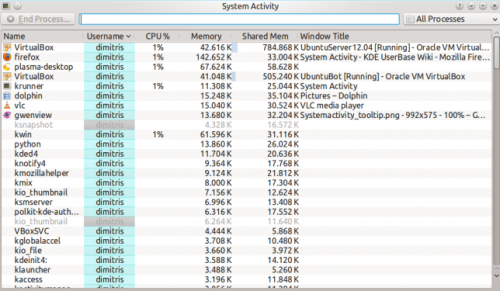
Consigli generali
Quasi ogni parte dell'interfaccia grafica visualizza un suggerimento. Quando ci passi sopra con il mouse fermandoti un attimo, per fornire informazioni maggiormente dettagliate e la funzionalità "Cos'è questo", attivata facendo clic sul pulsante ![]() , per spiegare il significato di queste informazioni.
, per spiegare il significato di queste informazioni.
Per esempio, passando con il mouse sopra l'utilizzo del processore da parte di un processo, possiamo vedere altre informazioni, compreso il tempo totale di esecuzione del programma.
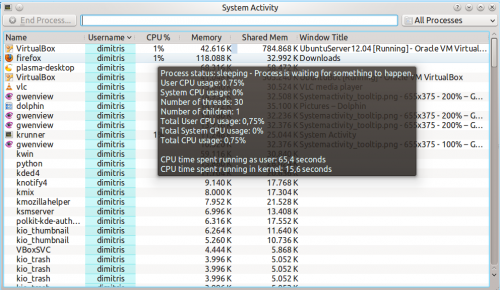
Perché il mio sistema è così lento in questo momento?
Un sistema può essere insolitamente lento a causa di un processo (programma) che richiede tutta la potenza di elaborazione del computer (utilizzo CPU) o che sta utilizzando tutta la memoria del computer.
In modo predefinito i processi di proprietà dell'utente attuale che stanno utilizzando molto il processore o la memoria sono posti vicino alla parte superiore. Questo significa che tutti i programmi con un comportamento anomalo dovrebbero essere in alto e quindi facilmente visibili. Per esempio:
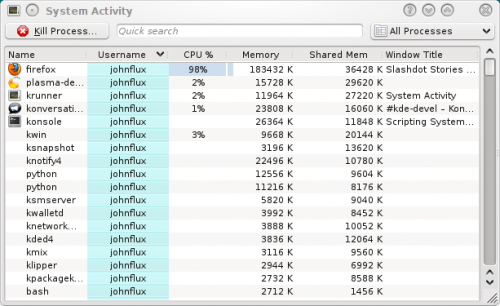
In questo esempio Firefox ha smesso di rispondere e sta utilizzando il 99% del processore.
Per terminare il processo che ha un comportamento anomalo, fai clic sul processo per selezionarlo e premi il pulsante . Questo invierà una gentile richiesta al programma, chiedendogli di chiudersi.
Non posso terminarlo, non vuole morire!
Per fortuna è abbastanza raro, ma potrebbe capitarti occasionalmente. Se il processo ha un comportamento anomalo, potrebbe ignorare la tua richiesta di chiusura, così potremmo aver bisogno di obbligare il programma a terminare immediatamente. Questa operazione può avere conseguenze su qualsiasi documento ecc che il programma ha aperto, ma non salvato. Per far questo, fai clic destro sul processo e scegli quindi scegli .
A volte anche questo non terminerà il processo o l'opzione potrebbe non essere disponibile. Può succedere, per esempio, in vuze con certi kernel. Se il processo o uno dei suoi thread viene preso in un bug del kernel, potrebbe finire per essere bloccato nel tentativo di eseguire un'operazione del kernel e diventare completamente non terminabile. Spesso non c'è altra soluzione che riavviare la macchina.
Processi zombie
I processi che sono nello stato zombie sono già morti e quindi non possono essere uccisi. Il sistema li tiene in giro fino a quando i loro processi genitori se ne accorgono, di solito è necessario poco tempo. Vedere un processo zombie indica di solito che il processo genitore ha smesso di rispondere.
Puntare una finestra per ucciderla
Se vuoi uccidere una specifica finestra che si è bloccata, semplicemente premi Ctrl + Alt + Esc in qualsiasi momento. Il cursore del mouse dovrebbe trasformarsi nell'immagine di un cranio con ossa incrociate. Ora fai clic sulla finestra che vuoi uccidere. Nota che questo ucciderà l'applicazione immediatamente e potresti perdere tutti i dati non salvati.
The Memory column shows approximately the amount of memory (RAM) that the process is using by itself, privately. The Shared Memory column is approximately the memory that is, or could be, shared with other programs. For example, the KDE libraries are used by all KDE programs and so are loaded into memory only once.
From KDE SC 4.4, you can right-click on a process and view the for the process to get more accurate readings.
Technical Information
The "Memory" column shows the value of VmRSS - Shared, and so is generally lower than the values shown by top etc. This does not include memory backed I/O pages, and does not include memory used by the x server to store any pixmaps used by the application. This value is often called the Unique RSS size, or URSS. This approximates the value shown as Private memory usage in the .
The Shared memory is the same as the SHR column in top and can be somewhat inaccurate. This approximates the value shown as Shared memory usage in the .
Specifically the process list parses /proc/pid/stat whereas the dialog parses /proc/pid/smaps.
How do I view more Detailed Memory Information about a process?
From KDE SC 4.4 you will be able to select a process in the table, right click on the process, and choose , and get something like:
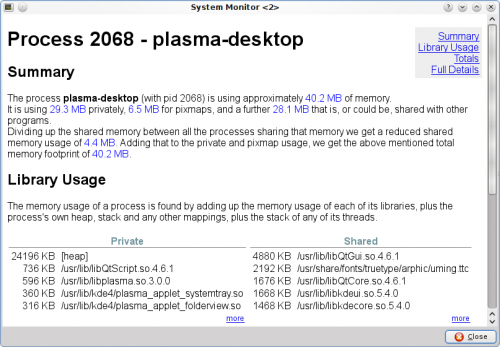
Why do values in Detailed Memory Information not match the process list?
The process list in System Activity is using an approximation to gather the values. The gives more accurate values.
Why is the "Xorg" process using so much memory?
This is the process that displays all the other applications. Its memory usage includes all the memory used on the video card to store all the pixmaps (images) from applications.
In general you do not need to worry about the memory usage of Xorg.
How do I see the PID of a process?
If you want to see the PID of a single process, hover the mouse cursor over the name of the process. The PID will be shown in the tooltip.
If you want to see the PID of all the processes, right click on any column heading and you will see the menu:
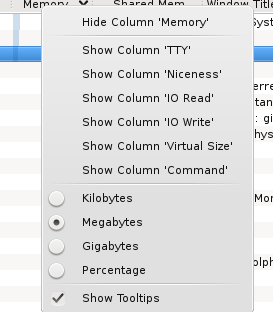
Choose .
Why are some processes grayed out?
For example the process xclock:

This means that the process has already died. It is shown as a disabled
process just for convenience to make it easier to see processes that are quit.
The values for the CPU usage, Memory usage, etc are just the values from when the process was last seen alive. A process that has ended does not take up any resources (it uses no CPU, memory etc).
What are all of these processes owned by root and taking up no memory?
These are kernel threads. They exist only inside the kernel, and exist to allow the kernel to perform multiple tasks in parallel.
They are shown because occasionally they can be a cause of heavy CPU usage. For example, under a heavy load, and with bad drivers, a network card can produce a huge number of interrupts, resulting in a high CPU usage in the ksoftirqd kernel thread.
Likewise, a high CPU usage in kjournald can indicate that DMA transfer is not enabled on the hard disk.
Why do I have so many processes?
A normal average-user system has around 150 to 200 processes with strange sounding names. It would be nice to setup a wiki page giving a short description of each of these processes, but so far nobody has done this. :-)
Why is OpenOffice.org not showing up as a graphical program?
Before version 3.3, OpenOffice.org did not correctly implement the window standards. Specifically, their windows did not set _NET_WM_PID to link the windows to the process. This is now fixed in OpenOffice.org 3.3.
